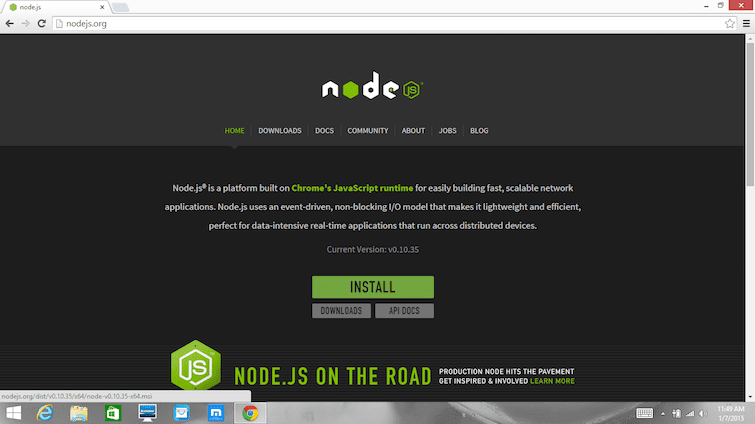

- INSTALL NODE JS MAC HOW TO
- INSTALL NODE JS MAC MAC OS
- INSTALL NODE JS MAC INSTALL
- INSTALL NODE JS MAC UPDATE
Npm install -g hope you like this tutorial please share your love and spread this post.
INSTALL NODE JS MAC UPDATE
To update current version of npm run following command: To install npm version you like you can first check the installed version of nodejs and npm as below: To uninstall specific node version you can run following command: Now, that you have multiple versions of nodejs each time you want to work with specific version of node js run following command to pick one you like:Ībove command will make v12.13.1 as a default node version. Now to install nodejs pick the version you like to install and run following command on your terminal window: This tool will help to install and the libraries and other tools to support react development.Let’s start with nodejs installation post completion on nodejs we will install create-react-app command line and will create a new react project1.Download nodejsVisit nodejs download page hereClick on macOS Installer to download the latest version of. To check available nodejs version run following command on your terminal window. Once you have nvm installed on your machine let's now install nodejs and nvm. Let's first install NVM (Node Version Manager) on our mac or linux machine using following tutorial: You can use nvm to manage different types of nodejs on your mac or linux machine. When you are working on different nodejs based projects it is good idea to work with multiple nodejs versions.
INSTALL NODE JS MAC MAC OS
You will need to set up the PATH environment variable in your terminal to have access to Yarn’s binaries globally.Īdd set PATH=%PATH% C:\.yarn\bin to your shell environment.Installing different versions of Nodejs on Mac OS or Ubuntu To do this, add export PATH="$PATH:`yarn global bin`" to your profile, or if you use Fish shell, simply run the command set -U fish_user_paths (yarn global bin) $fish_user_paths Windows To have access to Yarn’s executables globally, you will need to set up the PATH environment variable in your terminal. # Look for "Good signature from 'Yarn Packaging'" in the output Path Setup Unix/Linux/macOS To upgrade Yarn, you can do so with Homebrew. Yarn will warn you if a new version is available.

To do this, add export PATH="$PATH:`yarn global bin`" to your profile, or if you use Fish shell, simply run the command set -U fish_user_paths (yarn global bin) $fish_user_paths Upgrade Yarn # Look for "Good signature from 'Yarn Packaging'" in the output Path Setup If youre installing Node.js on your production environment you should. To do this, add export PATH="$PATH:`yarn global bin`" to your profile, or if you use Fish shell, simply run the command set -U fish_user_paths (yarn global bin) $fish_user_paths Note: We do not recommend using nvm to install Node.js for production environments. To access the node and npm executable from terminal make sure /usr/local/bin is in your PATH.

Before you begin, you should have a user account with. This guide assumes that you are using mac os.
INSTALL NODE JS MAC HOW TO
In the terminal, log in and log out for the changes to take effect How to Install Node.js on Mac Prerequisites.Add this to your profile: export PATH="$PATH:/opt/yarn-/bin" (the path may vary depending on where you extracted Yarn to).If Yarn is not found in your PATH, follow these steps to add it and allow it to be run from anywhere. This will point yarn to whatever version of node you decide to use. A workaround for this is to add an alias in your. Note: Due to the use of nodejs instead of node name in some distros, yarn might complain about node not being installed. Sudo apt update & sudo apt install -no-install-recommends yarn Most likely because some of the libraries or npm packages that you are using are not working natively with M1 yet.


 0 kommentar(er)
0 kommentar(er)
